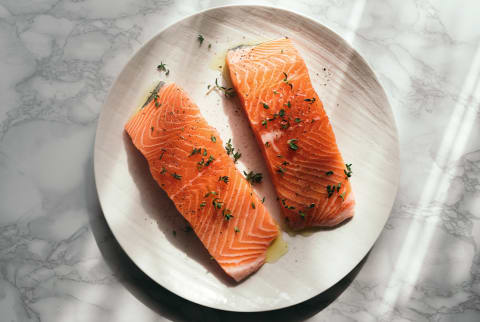Advertisement
Eating More Omega-3s Is Good For Blood Pressure & Heart Disease, Study Shows


Around 50% of all U.S. adults now have high blood pressure (aka hypertension). Considering this condition is a main risk factor for heart disease—which is the leading cause of death for both men and women—its prevalence is even more alarming.
Fortunately, your blood pressure is highly influenced by what you eat. Adopting healthy dietary patterns even after a hypertension diagnosis can greatly lower your blood pressure and chances of heart disease complications down the road.
As for what to eat to lower blood pressure after a hypertension diagnosis, a new study identified a particular type of fat to load up on. Here's what you need to know.
Eating more omega-3s is linked to improved cardiovascular longevity
A study in the journal Clinical Nutrition looked at the impact of eating foods rich in omega-3s in people who already had hypertension1.
Omega-3s have long been known for their heart health benefits, but few studies have investigated their impact on those with hypertension.
Researchers of this study looked at the diets of almost 27,000 adults with hypertension to see how many omega-3 fats they were consuming from both foods and supplements.
At the end of the study, they measured both all-cause and cardiovascular mortality (any death or death specific to heart conditions).
And sure enough, eating more omega-3 fats was linked to a significantly lower risk of both all-cause and cardiovascular mortality. For heart disease in particular, the risk was estimated to be 32% to 47% lower for those who ate more omega-3s.
What’s most impressive is that this relationship was significantly beneficial when looking at the intake of just one type of omega-3 fat. (As a reminder, there are three kinds: EPA and DHA are two types of omega-3s found in fatty fish and ALA is a plant-based omega-3 found in nuts and seeds.) So people with hypertension who consumed more EPA, DHA, and ALA had a 13%, 14%, and 11% (respectively) lower risk of cardiovascular mortality.
In this study, high ALA intake was defined as 1.2 to 1.6 grams daily, whereas high levels of EPA and DHA intake were deemed to be 250 milligrams.
How do omega-3s support blood pressure and protect against heart disease?
Omega-3s target blood pressure and heart health in various ways.
- They help improve blood flow: Studies indicate that EPA and DHA promote cells of blood vessel walls to release a compound called nitric oxide, which widens the blood vessel and relieves pressure on the blood vessel walls. Too high of pressure on your artery walls harms your heart over time by weakening the integrity of your blood vessels2.
- They combat oxidative stress: Oxidative stress from a buildup of free radicals3 actually reduces the production of compounds like nitric oxide—keeping blood flow restricted and blood pressure high. Omega-3s have antioxidant properties in the body that can help counter this reaction.
- They lower high triglyceride levels: Triglycerides are a measure of the amount of fat circulating in your blood. High levels of triglycerides are also a risk for heart disease, and the American Heart Association4 recommends increasing omega-3s to help manage them.
Increasing your omega-3 intake
Researchers of this latest study noticed that most of the participants' omega-3 intake (about 90% actually) came from ALA sources. As a reminder, these typically come from plant-based foods like chia seeds, flaxseeds, and walnuts.
While these foods are all nutritious, the ALA omega-3 acid is not efficiently used by the body, especially when compared to EPA and DHA.
Those are the two forms of omega-3s most of us need to focus on. And fatty fish (like salmon, mackerel, herring, and anchovies) are the best dietary sources of those fats.
And the most health benefits (especially when it comes to heart health) are linked to a daily intake of around 1,000 milligrams or more6.
You can exponentially bump up your fish intake, but this is when taking a high-quality omega-3 supplement may come in handy (here’s a list of our favorites).
The takeaway
Increasing the amount of omega-3s you get daily (both through food and supplements) is a smart way to protect your heart health, especially if your blood pressure is already running high.
It’s never too late to adjust your diet to support your health. And when it comes to hypertension and heart disease risk, making healthy changes—like bumping up your omega-3 intake—can strongly impact your longevity. `
6 Sources
- https://www.sciencedirect.com/science/article/abs/pii/S0261561423002984
- https://www.ncbi.nlm.nih.gov/books/NBK547743
- https://www.ncbi.nlm.nih.gov/pmc/articles/PMC2617738/
- https://www.heart.org/en/news/2023/06/30/are-you-getting-enough-omega-3-fatty-acids
- https://pubmed.ncbi.nlm.nih.gov/28956299/
- https://pubmed.ncbi.nlm.nih.gov/36742439/